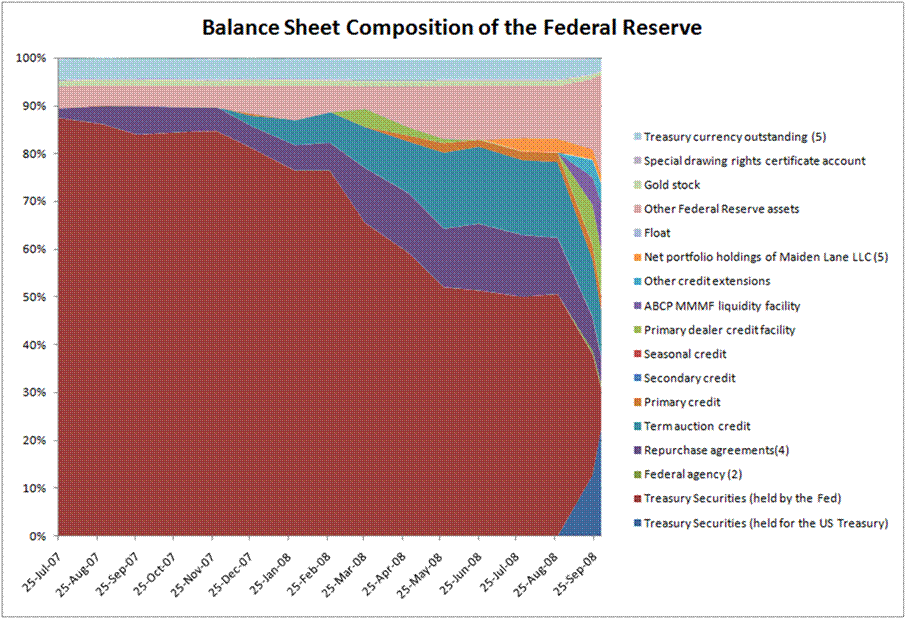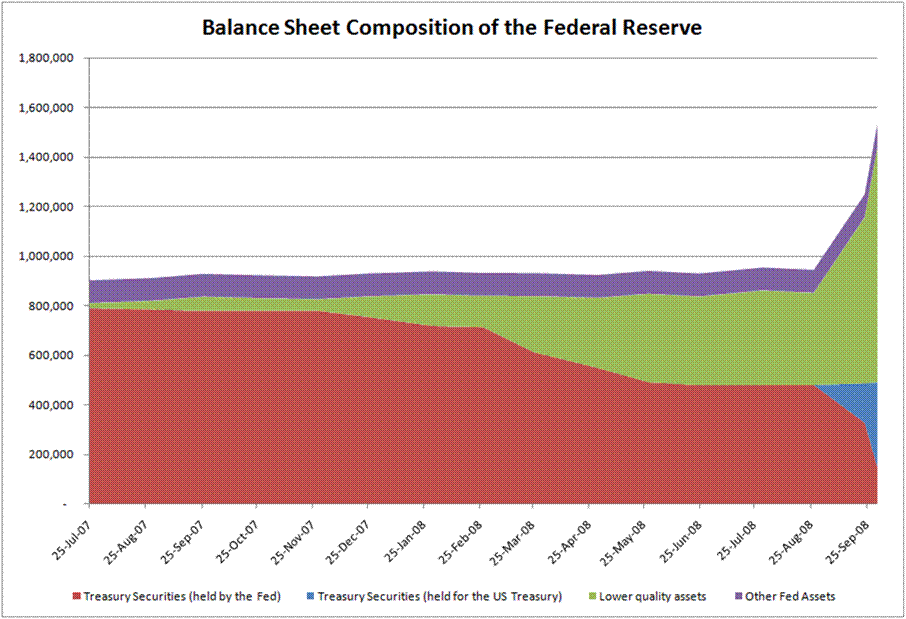Ten Takeaways from the Greenspan Years
Barry posted a link w/commentary to this Bob Woodward piece in the Washington Post.? I thought it was a good piece, but said to myself, “Wait.? He also wrote Maestro : Greenspan’s Fed and the American Boom. There would certainly be a good parallel piece there.”
So, though I am nowhere near as good a writer as Mr. Woodward, perhaps my knowledge of the markets might give me a good perspective on what Ben Bernanke should try to understand from his predecessor’s tenure.? With Greenspan, since monetary policy works with a lag, we have a better perspective today on what the true effects of his tenure were.
1) How you accept contributions from lesser players has an effect on policy.
Dr. Laurence Meyer gave a speech once, called Come with Me to the FOMC.? He explained how Alan Greenspan ran FOMC meetings, among other things.? When Greenspan wanted to assure a certain result, he would vote first.? If he was certain of the outcome, he would vote last.
Greenspan also enforced message discipline on FOMC members — there was a party line.? Give Bernanke credit, he lets the main players of the FOMC speak their own minds.
Because Greenspan had quite a reputation for promoting prosperity, this led to groupthink at the highest levels of the Fed.
2) A willingness to throw liquidity at every market fire creates the Greenspan Put.? The promise of liquidity is not free, because economic actors become more aggressive as bad debts are rescued rather than liquidated.
It began with the crash in 1987.? Greenspan was more than willing to throw liquidity at the crisis. Better he should have been silent, and let the market work its way out of the crisis.? He did the same thing with Mexico and RMBS in 1994, Commercial Real Estate in the early 90s, LTCM/Asia/Russia in 1998, Y2K in 1999-2000, and the aftermath of the tech bubble in 2001-2002.
Throughout his tenure the debt/GDP ratio grew, exceeding levels last seen during the Great Depression.? Bad debts grew, leading to our eventual crisis today.
3) Monetary policy should consider asset prices.
Greenspan was unwilling to consider the effect of asset prices on monetary policy in any major way until the end of his term.? Consider this CC post:
| David Merkel | ||
| When Alan Greenspan Talks, the Market Listens (Apologies to E.F. Hutton) | ||
| 8/26/2005 10:32 AM EDT |
As Alan Greenspan does his “Farewell Tour,” today in Jackson Hole, Wyo., he said the following in his speech:
The structure of our economy will doubtless change in the years ahead. In particular, our analysis of economic developments almost surely will need to deal in greater detail with balance sheet considerations than was the case in the earlier decades of the postwar period. The determination of global economic activity in recent years has been influenced importantly by capital gains on various types of assets, and the liabilities that finance them. Our forecasts and hence policy are becoming increasingly driven by asset price changes.
The steep rise in the ratio of household net worth to disposable income in the mid-1990s, after a half-century of stability, is a case in point. Although the ratio fell with the collapse of equity prices in 2000, it has rebounded noticeably over the past couple of years, reflecting the rise in the prices of equities and houses.
Whether the currently elevated level of the wealth-to-income ratio will be sustained in the longer run remains to be seen. But arguably, the growing stability of the world economy over the past decade may have encouraged investors to accept increasingly lower levels of compensation for risk. They are exhibiting a seeming willingness to project stability and commit over an ever more extended time horizon.
The lowered risk premiums–the apparent consequence of a long period of economic stability–coupled with greater productivity growth have propelled asset prices higher.5 The rising prices of stocks, bonds and, more recently, of homes, have engendered a large increase in the market value of claims which, when converted to cash, are a source of purchasing power. Financial intermediaries, of course, routinely convert capital gains in stocks, bonds, and homes into cash for businesses and households to facilitate purchase transactions.6 The conversions have been markedly facilitated by the financial innovation that has greatly reduced the cost of such transactions.
Thus, this vast increase in the market value of asset claims is in part the indirect result of investors accepting lower compensation for risk. Such an increase in market value is too often viewed by market participants as structural and permanent. To some extent, those higher values may be reflecting the increased flexibility and resilience of our economy. But what they perceive as newly abundant liquidity can readily disappear. Any onset of increased investor caution elevates risk premiums and, as a consequence, lowers asset values and promotes the liquidation of the debt that supported higher prices. This is the reason that history has not dealt kindly with the aftermath of protracted periods of low risk premiums. In short:
No one can tell what Greenspan’s successor will do, but rhetoric like this indicates an inverted curve until excesses (real or imagined) can be wrung out of the system.
The market reacted badly when his speech hit the wires. It will do worse if the FOMC carries through on the logical implications of what he has said. (Leaving aside for a moment the friendly foreigners that are more than undoing the FOMC’s tightening actions…)
=–==-
Now this had little effect for most of his term, but at the end he was worried.? Reality was catching up with neoclassical dogmatism.
4) Greater length of monetary tightness is a good thing, as is shorter lengths of monetary looseness.
Greenspan had a willingness to loosen for too long, and an unwillingness to let monetary tightness really bite.? This was another part of the Greenspan Put.? He was never willing to disappoint the asset markets for too long.? There is some evidence that he used Fed funds futures to set policy; during the Greenspan years, it was a very good predictor of policy.? I began to wonder whether the tail was wagging the dog.? Fed funds was such a good predictor of Fed behavior one month in advance of FOMC meetings that one did not have to consider much else.
5) Don’t tolerate bad bank loan underwriting.
The Federal Reserve leads bank regulation in the US, and they encourage bank examiners to be tough or loose.? There was a long period of encouraging looseness in bank regulation, and it has led to significant loan losses in our banking system.
In a fiat money system, control of credit is the key thing.? Allowing the banking system to run amok is not helpful to free market economics, because of the resultant depressions.? The ability of banks to extend credit should be limited; without limits, or with loose limits, banks encourage the economy to overexpand, leading to recessions, and occasional depressions.
6) Don’t allow banks to own any assets that you don’t understand, or can’t be valued in tough market environments.
Regulators must bar regulated entities from buying financial instruments that cannot easily be valued.? Regulated entities must be safe institutions even if it hurts their ROEs.? Greenspan encouraged a simple-minded approach to derivative instruments, without considering the systemic effect from their use.
Securitization was another tough concept.? Banks and pseudo-banks originated loans that they would not have if they had to retain them themselves.? That created more systemic risk.
Banks should have been barred from holding assets that were new.? By new, I mean any class of assets that has not suffered market failure, so that the loss potential and illiquidity during a bear market could be estimated fairly, and the proper risk-based capital level set.
By encouraging banks to use their own internal risk models, Greenspan and those that favored the Basel II framework encouraged banks to make aggressive assumptions, and do more business than their capital could bear.
7) Don’t become a tool of the Executive branch, nor of Congress
Greenspan happily sat beside First Ladies during State of the Union Addresses.? He met with the executive branch more than any other Fed Chairman.? He facilitated the economic politics of the government, regardless of who was there.? Consider the plunge protection team during the LTCM era, or his statements after Black Monday in 1987.
Better Fed Chairmen dissed both Congress and the executive, and did their duty.? Consider Volcker during the hard times, William McChesney Martin, or Thomas McCabe.? They opposed the political establishment, and left monetary policy tighter than the politicians would have liked.
8 ) The Fed Chairman should not be the Chief Economist of the US
Perhaps it is another way of running down the shot clock when in front of Congress, but the Fed Chairman is not supposed to be a political figure.? Questions not pertaining to maonetary policy should be ignored.? Score a few points for Ben Bernanke.
Aside from that, Greenspan had many dumb comments over — Irrational Exuberance, ARMs, and Derivatives including Credit Derivatives.
9) Obfuscation pays, but jawboning the markets only works in the short run.
From an old CC post:
| |
David Merkel | ||
| Greenspeak: A Foreign Language to All | |||
| 4/21/04 12:53 PM?ET |
|||
| Adam, your question is very applicable. My view on Greenspan is that he tries to get the market to do his bidding, rather than always using the explicit policy tools that the Fed has. He speaks ambiguously for a number of reasons:1. If he speaks too clearly, the market will immediately adjust to what the Fed is going to do, and the actual use of their policy instruments will have little impact.
2. He genuinely tries to express the degree of uncertainty inherent in the data and theory underlying economics, as well as the political backdrop. 3. If he answers too quickly and directly, he will get more questions. In basketball, this is called “running down the shot clock.” 4. I think he uses obfuscation tactically to make it easier to adjust market expectations. He can give occasional clear statements to bump the bond market where he wants it tactically to go in the short run, which may be different than where he thinks it has to go in the long run. 5. I think he enjoys it. At present, I think Greenspan wants to keep things near where they are, which allows the economy to grow fairly rapidly to absorb labor market slack. To me, that means targeting the 10-year Treasury between 4% and 4.50% or so. Unless there is a marked pickup in his favored inflation gauge, or a huge decline in the dollar, I don’t see the FOMC being compelled to raise the fed funds rate. To raise rates for the abstract reason of reducing leverage in the fixed income market will not play well politically, particularly in an election year. All my opinions, but I have been watching the Fed for 20 years… No stocks mentioned |
|||
In addition, because Greenspan had such a good reputation during his time as Fed Chairman, obscure comments would be reinterpreted to favor the the views of the one questioning Greenspan.
We are currently in an era where jawboning does not work well, because of the overleverage in the financial system. Jawboning works when economic actors are unafraid of systemic worries, and are only concerned with relative performance in the own local markets.
But it led market players to think”Hey, the Fed has my back,” and so they could take more risks on average.
10) Merely because measured employment is strong, and measured inflation is low, does not mean monetary policy is being conducted properly.
There are three factors that led to monetary policy to be more asset-inflationary, leading the more credit-sensitive monetary aggregates to expand more aggressively while measured consumer price inflation remained low.
First, foreigners were willing to stimulate the US economy in excess of the Fed in order to build up their own manufacturing bases. As such, foreign central banks bought in our debt, financiang our current account deficit, helping our interest rates go below where they would have been in their absence. Bernanke and Greenspan called it the “savings glut,” but they should have tightened policy to compensate.
Second, demographics favored high employment and low inflation, as the Baby Boomers entered the prime of life. Through their institutional agents, pension plans, and their own private actions, a greater amount of risk was taken to finance the future cash flow needs of the Baby Boomers. P/Es were bid up, and interest rates bid down through the 80s, 90s, and 2000s.
Credit spreads were bid down as well, culminating in three major credit boom-busts, which peaked in 1989, 2000, and 2006, respectively. Monetary policy facilitated those cycles by being too aggressive in providing liquidity, creating the boom. The punchbowl should have been taken away sooner. At least, margin requirements should have been raised.
Third, through securitization, more credit was extended than in previous periods relative to the Fed’s ability to control it. Some securitization went on outside of the banks, so it was outside of the Fed’s direct control. Some went on through the banks, but the banks bought many of the securitized debts, the creditworthiness of which is presently suspect. As I argued above, the Fed should have not allowed the banks to invest in asset classes that had not been through a failure cycle.
The Fed should have leaned against the wind on all of these factors to slow down the aggressive growth of debt that now paralyzes our economy. To the extent that that is not in their charter, blame should be laid at the door of Congress. But since the Fed has responsibility for the health of the banking system, they should have addressed these three factors, and considered monetary policy in broader terms.
Instead, Greenspan aided every boom, and never let the busts clear away marginal investments by coming to the rescue too soon. That is his legacy, and we are living with it now.






